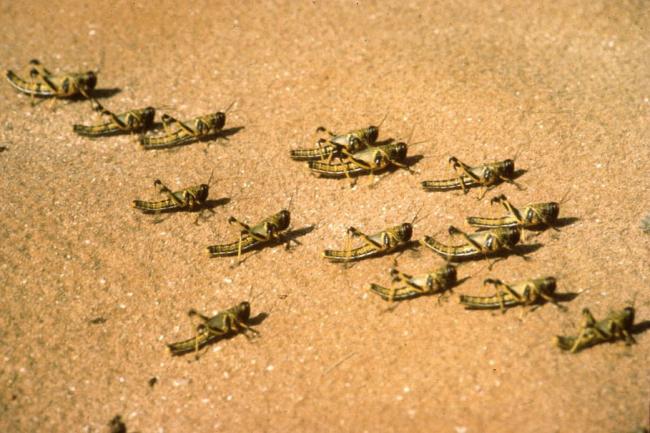
Desert Locust outbreak in Yemen leaves surrounding countries potentially at risk
The UN agency urged neighbouring countries, including Saudi Arabia, Oman and Iran, to mobilize, survey and control teams, and to take all necessary measures to prevent the destructive insects from reaching breeding areas situated in their respective territories.
Strict vigilance is also required in Morocco and Algeria, especially in areas south of the Atlas Mountains, which could become possible breeding grounds for Desert Locust that have gathered in parts of the Western Sahara, Morocco and Mauritania, FAO added.
Cyclones help trigger locust presence
Groups of juvenile wingless hoppers and adults as well as hopper bands and at least one swarm formed on the southern coast of Yemen in March where heavy rains associated with tropical cyclones Chapala and Megh fell in November 2015.
"The extent of current Desert Locust breeding in Yemen is not well known since survey teams are unable to access most areas. However, as vegetation dries out along the coast more groups, bands and small swarms are likely to form," said Keith Cressman, FAO Senior Locust Forecasting Officer, in a press release.
He noted that a moderate risk exists that Desert Locusts will move into the interior of southern Yemen, perhaps reaching spring breeding areas in the interior of central Saudi Arabia and northern Oman.
There is a possibility that this movement could continue to the United Arab Emirates where a few small swarms may appear and transit through the country before arriving in areas of recent rainfall in southeast Iran.
FAO is assisting technical teams from Yemen's Ministry of Agriculture and Irrigation in conducting field survey and control operations in infested coastal areas, as part of the agency's continuing support to the country's locust control efforts.
It also warned that in northwest Africa, small groups and perhaps a few small swarms could find suitable breeding areas in Morocco (Draa Valley), Mauritania (near Zouerate) and Algeria. In addition, some small-scale Desert Locust breeding is likely to occur in southwestern Libya, but numbers should remain low.
The agency stressed the need for close monitoring in all of these areas over the next few months to prevent the insects from forming large, destructive swar
The Desert Locust situation in other countries reportedly remained calm in March with no significant developments detected or expected.
A force of nature
Desert Locust hoppers can form vast ground-based bands. These can eventually turn into adult locust swarms, which, numbering in the tens of millions can fly up to 150 km a day with the wind.
Female locusts can lay 300 eggs within their lifetime while an adult insect can consume roughly its own weight in fresh food per day – about two grams every day. A very small swarm eats the same amount of food in one day as about 35,000 people and the devastating impact locusts can have on crops poses a major threat to food security, especially in already vulnerable areas.
Locust monitoring, early warning and preventive control measures are believed to have played an important role in the decline in the frequency and duration of plagues since the 1960s; however, on Tuesday climate change is leading to more frequent, unpredictable and extreme weather and poses http://www.fao.org/ag/locusts/en/activ/1307/climate/index.html on how to monitor and respond to locust activity.
FAO informed that it operates a Desert Locust Information Service that receives data from locust-affected countries. This information is regularly analyzed together with weather and habitat data and satellite imagery in order to assess the current locust situation, provide forecasts up to six weeks in advance and if required issue warnings and alerts.
FAO also undertakes field assessment missions and coordinates survey and control operations as well as assistance during locust emergencies. Its three regional locust commissions provide regular training and strengthen national capacities in survey, control and planning.
Photo: FAO/G.Tortoli
Support Our Journalism
We cannot do without you.. your contribution supports unbiased journalism
IBNS is not driven by any ism- not wokeism, not racism, not skewed secularism, not hyper right-wing or left liberal ideals, nor by any hardline religious beliefs or hyper nationalism. We want to serve you good old objective news, as they are. We do not judge or preach. We let people decide for themselves. We only try to present factual and well-sourced news.







